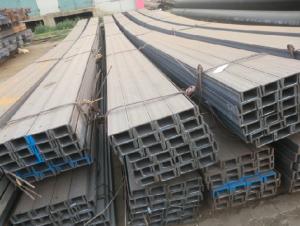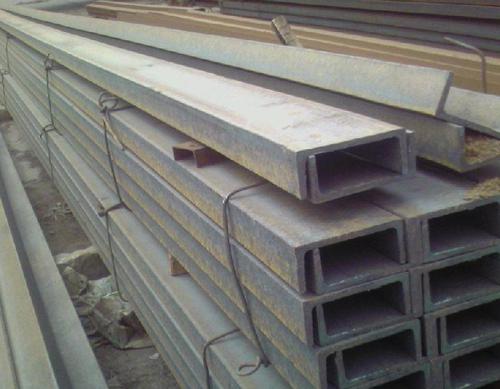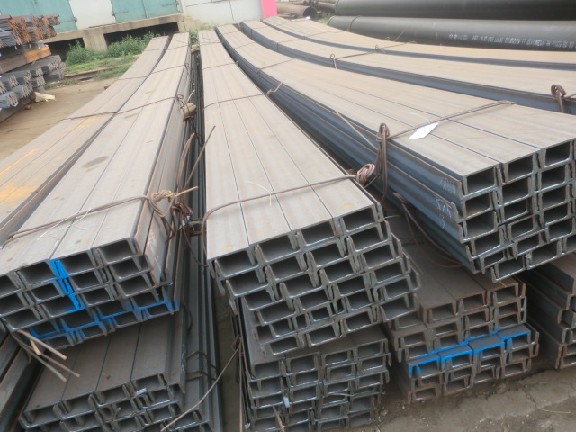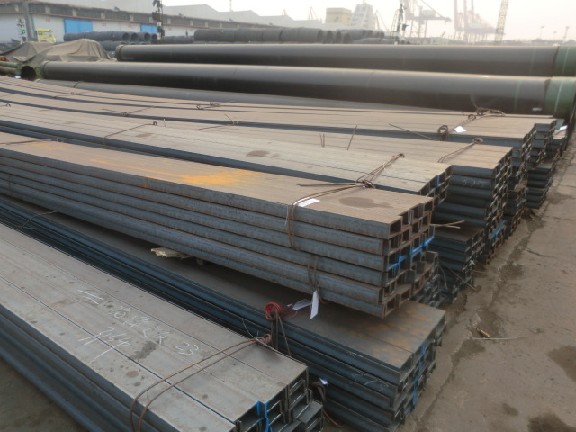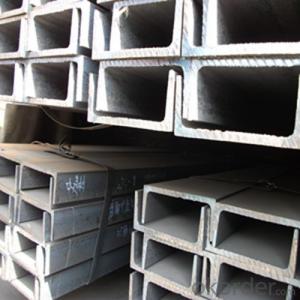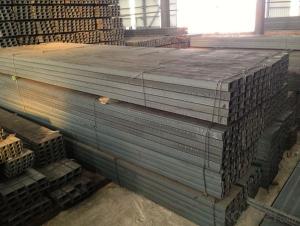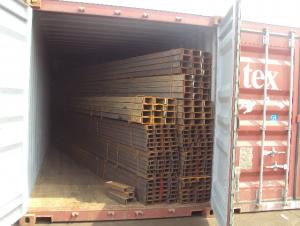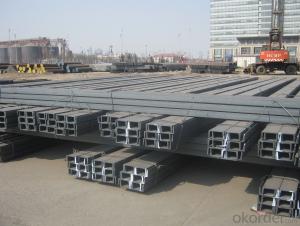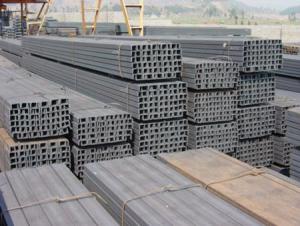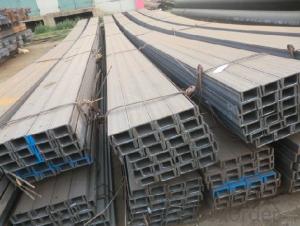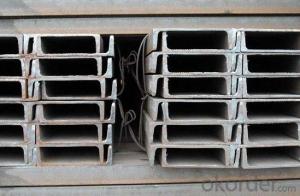MS GB Standard Steel Channel
- Loading Port:
- China Main Port
- Payment Terms:
- TT OR LC
- Min Order Qty:
- -
- Supply Capability:
- -
OKorder Service Pledge
OKorder Financial Service
You Might Also Like
Specifications of Hot Rolled Channel Steel:
1. We are definitely specializing in manufacturing and supplying channel steel.
| Standard: | GB |
| Material/Grade: | Q235 |
| Sizes: | 50mm to 280mm |
| Sales Volume/Year: | 3000MT |
| Destination Area: | Middle East, Africa, Southeast Asia |
2.Size, Length and Mass.
| Size(mm) | Length(m) | Mass(Kg/m) |
180*68*7.0*10.5 mm | 6m, 12m | 20.174 kg/m |
| 180*70*9.0*10.5 mm | 6m, 12m | 23.000 kg/m |
Package & Delivery of Channel Steel:
The steel u channel will be packed in bundle with steel wire at each end of every bundle and color marking in order to help the customer to recognize his goods more easily at sight.
And steel u channel could be loaded into 20ft or 40ft container, or by bulk cargo. If the weight of each bundle reaches less than 3.5 mt, the loading by break bulk cargo should be choosed. When the weight of each bundle reaches less than 3mt, the loading by container should be choosed.
As for the transportaion from mill to loading port, the truck will be usually used. And the maximum quantity for each truck is 40mt.
All in all, we could do in accordance with customer's request.
If you would like to get our price, please inform us the standard/material, size and quantity. Thank you very much.
- Q: Can steel channels be used in the construction of architectural canopies?
- Indeed, architectural canopies can certainly incorporate steel channels into their construction. The utilization of steel channels in construction is widespread owing to their robustness and resilience. These channels offer essential structural reinforcement and stability, rendering them highly suitable for architectural canopies that must endure diverse weather conditions and burdens. Furthermore, steel channels can be skillfully fashioned and molded into various shapes to comply with the canopy's design prerequisites. Depending on the precise design and structural specifications, they can serve as either the primary framework component or as secondary supporting elements. All in all, due to their strength, adaptability, and capacity to enhance the structure's aesthetics, steel channels are widely favored for architectural canopy construction.
- Q: How do steel channels contribute to the stability of mezzanine floors?
- Steel channels are essential components in the construction of mezzanine floors and play a crucial role in contributing to their stability. These channels, also known as C-channels or C-sections, are made of high-strength steel and are specifically designed to provide structural support and reinforcement. One of the main ways steel channels contribute to the stability of mezzanine floors is by distributing the load evenly across the floor structure. Mezzanine floors are designed to accommodate heavy loads, such as machinery, equipment, or storage materials. The steel channels act as beams that bear the weight and transfer it to the vertical supports or columns. By distributing the load, they prevent localized stress concentration and ensure the overall stability of the floor. Furthermore, steel channels add rigidity to the mezzanine floor system. Due to their shape and structural properties, they offer excellent resistance to bending and torsion forces. This rigidity is crucial in preventing any excessive deflection or movement of the floor, especially when subjected to dynamic loads or vibrations. The stability provided by the steel channels enhances the safety and functionality of the mezzanine floor, allowing it to withstand heavy usage and ensure a secure work environment. Moreover, steel channels contribute to the overall durability and longevity of mezzanine floors. Steel is a highly durable material that can withstand a wide range of environmental conditions, such as temperature variations, moisture, and corrosion. By using steel channels, the structural integrity of the mezzanine floor system is enhanced, minimizing the risk of deformation, sagging, or structural failure over time. This durability ensures that the mezzanine floor can endure heavy loads for an extended period, reducing the need for frequent maintenance or replacement. In summary, steel channels play a vital role in contributing to the stability of mezzanine floors by distributing loads evenly, providing rigidity, and enhancing durability. Their structural properties ensure the safety, functionality, and longevity of mezzanine floors, making them an essential component in their construction.
- Q: What is the standard length of steel channels?
- The standard length of steel channels can vary depending on the specific industry and application. However, in general, steel channels are commonly available in standard lengths of 20 feet or 6 meters. These lengths are often chosen to facilitate easy transportation and handling, as well as to align with common building and construction practices. It is important to note that custom lengths can also be obtained based on specific project requirements, but the standard length of 20 feet or 6 meters is widely used and readily available in the market.
- Q: What are the common surface treatments for steel channels?
- Steel channels can be treated with various surface treatments to protect them from corrosion and enhance their appearance. Some common options include: 1. Galvanizing: A layer of zinc is applied to the steel channel, providing excellent durability and protection against harsh environmental conditions. 2. Powder coating: Dry powder is applied to the steel channel, which is then heated and cured to create a durable and attractive finish. This treatment offers resistance to chipping, scratching, and fading. 3. Painting: A layer of paint is applied to the surface of the steel channel to improve its appearance and protect it from corrosion. Different types of paints, such as epoxy, acrylic, or enamel, can be used for varying levels of durability and aesthetics. 4. Anodizing: Although primarily used for aluminum, anodizing can also be applied to steel channels. This process creates a protective oxide layer on the metal's surface, increasing its resistance to corrosion, abrasion, and wear. 5. Black oxide coating: A chemical process is used to create a black finish on the steel channel, enhancing its aesthetic appeal and providing some corrosion resistance. This treatment is often used for decorative purposes and to reduce light reflection. 6. Passivation: Stainless steel channels can undergo passivation, a chemical process that removes impurities from the surface, improving their corrosion resistance. This treatment eliminates free iron and other contaminants, preventing rust and increasing the steel's longevity. When choosing a surface treatment for steel channels, it is important to consider the specific requirements of the application and seek advice from professionals to determine the most suitable option.
- Q: 10kV and below the distribution cabinet in the room, the basic channel should be higher than the indoor ground level? Which specification is clearly defined?
- The electrical energy of a circuit in a distribution device is assigned to the nearest load. This class of equipment provides protection, monitoring and control of loads.
- Q: What are the common surface finishes available for steel channels?
- Steel channels have several options for surface finishes. These finishes serve to enhance their appearance, protect against corrosion, and improve durability. One popular surface finish is a plain or mill finish. This finish involves leaving the steel channels in their natural state after manufacturing. It results in a smooth, slightly reflective surface, but does not offer additional corrosion protection. Another common surface finish is hot-dip galvanizing. This process entails immersing the steel channels in molten zinc, creating a protective coating. Hot-dip galvanized steel channels appear dull gray and provide excellent corrosion resistance, making them ideal for outdoor or high-moisture environments. Powder coating is also favored for steel channels. It involves applying a dry powder electrostatically and then curing it with heat. Powder-coated steel channels have a smooth, durable finish and are available in many colors. This finish offers good corrosion resistance and is commonly used indoors. Furthermore, steel channels can be painted using various paint finishes applied by spray, roller, or brush. Painted steel channels provide aesthetic appeal and can be customized to match specific color requirements. They also offer some corrosion protection, with the level varying based on paint quality and application process. In summary, common surface finishes for steel channels include plain or mill finish, hot-dip galvanizing, powder coating, and paint finishes. Each finish offers distinct advantages in terms of appearance, corrosion resistance, and durability. The choice of surface finish depends on the application's specific requirements and desired outcome.
- Q: Are steel channels suitable for use in the construction of elevated storage systems?
- Yes, steel channels are suitable for use in the construction of elevated storage systems. Steel channels offer several advantages that make them a popular choice for such applications. Firstly, steel channels are known for their high strength and durability. They can withstand heavy loads and provide structural stability, making them ideal for supporting elevated storage systems. Additionally, steel channels have excellent resistance to corrosion, which is crucial in storage systems where exposure to moisture or harsh environmental conditions may occur. Furthermore, steel channels are versatile and can be easily fabricated into various shapes and sizes to meet specific design requirements. This allows for flexibility in constructing storage systems of different dimensions and configurations. Steel channels also offer ease of installation and can be efficiently connected using various methods such as welding or bolting. Another advantage of using steel channels in elevated storage systems is their cost-effectiveness. Steel is a relatively affordable material compared to alternatives like aluminum or composite materials. Additionally, steel channels require minimal maintenance over their lifespan, reducing long-term costs. Overall, the strength, durability, resistance to corrosion, versatility, and cost-effectiveness of steel channels make them highly suitable for use in the construction of elevated storage systems.
- Q: What are the different methods for transporting and handling steel channels?
- There are several different methods for transporting and handling steel channels, depending on the specific requirements and logistics of the situation. Some of the commonly used methods include: 1. Crane lifting: Steel channels can be transported and lifted using cranes equipped with hooks or lifting magnets. This method is ideal for large-scale projects or when handling heavy steel channels. 2. Forklifts: Forklifts with specialized attachments can be used to transport steel channels within a facility or construction site. This method is suitable for smaller and lighter steel channels, allowing for more precise movement and placement. 3. Conveyor systems: In manufacturing settings, conveyor systems can be implemented to transport steel channels from one process to another. This method is efficient and reduces the need for manual handling. 4. Flatbed trucks: Steel channels can be loaded onto flatbed trucks for transportation over long distances. The channels are secured using straps or chains to prevent movement during transit. 5. Palletizing: Steel channels can be stacked and secured on pallets for easier handling and transportation. This method is common when shipping smaller quantities of steel channels or for storing them in a warehouse. 6. Rollers or skids: Steel channels can be moved along rollers or skids for short distances within a facility or construction site. This method allows for easy movement and positioning of the channels. 7. Rail transportation: For larger quantities or longer distances, steel channels can be transported via rail. Specialized rail cars or containers are used to safely secure and transport the channels. It is important to consider the size, weight, and fragility of the steel channels when determining the appropriate method for transporting and handling them. Safety measures should always be followed to prevent accidents, and specific equipment may be needed depending on the chosen method.
- Q: Can steel channels be used for racking systems?
- Yes, steel channels can be used for racking systems. Steel channels provide a strong and durable solution for storing heavy loads. They are typically designed with a C-shape, allowing for easy installation and providing a sturdy support structure for the racking system. Steel channels can be used in various types of racking systems, such as pallet racks, cantilever racks, and mezzanine racks. They offer excellent load-bearing capabilities and can withstand the weight and pressure exerted by the stored items. Moreover, steel channels are resistant to corrosion, making them suitable for both indoor and outdoor racking systems. Overall, steel channels are a reliable and versatile choice for constructing efficient and safe racking systems.
- Q: How do steel channels contribute to sound insulation in buildings?
- Steel channels can contribute to sound insulation in buildings in several ways. First, steel channels can be used to create a resilient channel system. This involves attaching the channels to the wall or ceiling studs and then attaching the drywall to the channels, rather than directly to the studs. This creates a gap between the drywall and the studs, which helps to reduce the transmission of sound vibrations from one side of the wall to the other. Additionally, steel channels can be used to create sound isolation walls or partitions. By installing multiple layers of drywall with steel channels in between, the channels help to absorb and dissipate sound energy. This can greatly reduce the transfer of sound from one room to another, creating a quieter and more comfortable environment. Furthermore, steel channels can also be used to support acoustical insulation materials. By filling the cavity between the steel channels with materials such as mineral wool or fiberglass, the channels help to absorb sound and reduce its transmission. This combination of the steel channels and insulation materials creates a more effective sound barrier, improving the overall sound insulation in the building. Overall, steel channels play a crucial role in sound insulation in buildings by providing structural support for resilient channel systems, creating sound isolation walls, and supporting acoustical insulation materials. By utilizing steel channels in these ways, the transmission of sound vibrations can be significantly reduced, leading to a quieter and more peaceful indoor environment.
Send your message to us
MS GB Standard Steel Channel
- Loading Port:
- China Main Port
- Payment Terms:
- TT OR LC
- Min Order Qty:
- -
- Supply Capability:
- -
OKorder Service Pledge
OKorder Financial Service
Similar products
Hot products
Hot Searches
Related keywords

